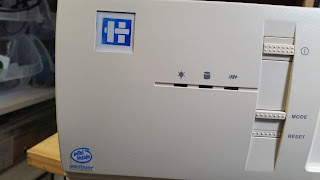The Original Pentium: The original Gaming Rig
Though I was gaming back as early as the original 8086/8088 IBM PC (and even before that, with Apple 2, TRS-80's, and early 8-bit home computers), the first big jump in gaming came when the first Pentium-based PC Clones hit the market. The 486-DX2-66 I had was replaced by a Pentium 166Mhz Main board with 1 GB of RAM. This was the era just before Windows 95 became available, when most of us were still running DOS and Windows 3. The Pentium gave us a new level of speed and performance that made the classic games, like Quake, possible. Older classics like Doom and Duke Nukem 3-D could now be enjoyed at full speed with the highest resolution offered -- 640x480 or 800x600. The era of the first-person shooter was kicked up a notch with 3D accelerator cards and a Pentium. Don't forget the Sound Blaster!
So I had no intention of getting this Pentium PC. The owner said that it was practically never used. But it was just a generic case and system in general. Then I thought about what I could do with it. With Floppy Drives, I could use it as a floppy drive imaging station or at least a floppy disc reading station for copying software to more modern media. It was only $30 and had a keyboard. Yeah -- just $30, and it looked almost new... but I'm seriously out of space in my computer refurbishing workshop!
I ended up getting it, along with a TRS-80 Color Computer that had a bunch of Program Packs. Total cost $50.



When I opened it up, I noticed this filth in the corner. It just looked like a load of dust, or maybe rust, but on closer inspection, it smelled of oil. So it was oil mixed with dust that had accumulated over the last 25-30 years. Really nasty. I had to clean this up and see if I can prevent the working computer from having issues related to this spill.

My weapons of choice: Good old Alcohol, and 2 kinds of Contact cleaner. I also used disposable dust-free wipes, cotton swabs, and a toothbrush.


After cleaning, the Soundblaster seemed much cleaner, and looked almost like new. Later testing revealed that it was still working.


The Motherboard was a little tougher to clean. The 16-bit ISA slots were full of oil, and were difficult to get in between, even with my trusty toothbrush. After repeated cleanings, I finally managed to get the oil off of it. I noted that the oil came off when I used the cleaning wipes -- yellow stains on the wipes were oil. Once I was able to clean the board without any more yellow oil stains, I figured that it was good to go. The slots were the most difficult, because I didn't know if oil got deposited inside of them. Fortunately, it looks like that wasn't the issue, as both slots work.

So here are the components that came with it...
We have a Toshiba XM-6002B 16X CD-ROM Drive.

A Western Digital Caviar 2.1GB Hard Drive.

An ATI Mach64 GT Graphics accelerator (Not a 3D accelerator)
 A working standard Sony 3.5" 1.44 Floppy.
A working standard Sony 3.5" 1.44 Floppy.

So I was confused why this was in there. The multi-I/O card had serial, parallel, IDE and Floppy Controller on it -- but the motherboard had all of those already. When I saw this, I immediately went into the BIOS to make sure that all the on-board hardware was enabled. It seems they were really interested in the floppy controller part of the board. The on-board floppy controller was disabled, but everything else was enabled. Th problem is -- nothing on the motherboard is broken, and the performance of this all-in-one card isn't any better than the motherboard. In any case, I'll just use this in another computer.


I added an Audio cable from the CD-ROM drive to the sound card. The PC didn't seem to come with one.

 The 2.1G Hard Drive worked, and ran Windows 2000. I decided to leave it out for now, and go with a modern gadget -- the CF-CARD to IDE adapter! This will allow me to use a CF card like a hard drive -- only faster and more reliable -- and I can remove the card and plug it into my modern desktop to install more programs onto it. I can also have a card for different Operating systems. The card requires a power supply connector, and a slot.
The 2.1G Hard Drive worked, and ran Windows 2000. I decided to leave it out for now, and go with a modern gadget -- the CF-CARD to IDE adapter! This will allow me to use a CF card like a hard drive -- only faster and more reliable -- and I can remove the card and plug it into my modern desktop to install more programs onto it. I can also have a card for different Operating systems. The card requires a power supply connector, and a slot.

The ATI Logo is animated and spins around when it posts.


Everything seems to be working so far...

So MSDOS6.22 boots up just fine on the flash card. See any familiar directories?
LET'S PLAY SOME GAMES!















The last picture is me looking over my cat's shoulder as she makes herself comfortable right in the middle of what I'm doing.





